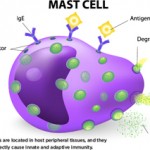 I was cleaning out an old storage closet in my parents’ house in Florida when I stumbled across some notes I took in medical school. As I leafed through pages and pages of notes filled with doodles and reminders, I found a statement that gave me pause: “Immunology—what is it good for?!”
I was cleaning out an old storage closet in my parents’ house in Florida when I stumbled across some notes I took in medical school. As I leafed through pages and pages of notes filled with doodles and reminders, I found a statement that gave me pause: “Immunology—what is it good for?!”
To be honest, I don’t remember if it was something the professor had said, or whether it was a comment that came out of frustration with the dense subject matter. It was, after all, set next to a very elaborate depiction of the complement pathways. Nevertheless, I found it extremely funny that 15 years later, I would be a doctor who treats immune diseases of all varieties. Then I thought that perhaps there’s another student (or cynical lecturer) out there who has the same sentiment. As the ACR journal, Arthritis & Rheumatology, starts a series on immunology for the practicing rheumatologist, the topic is worth a second look. So, immunology—what is it good for? Let’s rheuminate.
A Deeper Understanding of Disease
The vast majority of rheumatic diseases are rooted in the immune system. In fact, I would say that almost every disease, from ankle sprains to heart attacks, has an element of immune dysfunction.1 As we start to gain more knowledge about the pathogenesis of these diseases, we’ve started to see unmistakable evidence of cross talk between the various arms of the immune system and other organ systems. This newer, emergent body of knowledge is often dense, but it’s vital to understand because it brings us a deeper understanding of our own sense of health and illness.
A wonderful example of this is the complement cascade that my younger self seemed to bristle at. Although it doesn’t seem like I need to know every single step of the disease process to be a practicing rheumatologist, I recognize that having an appreciation for the grander scheme of these positive and negative reinforcement cycles makes me a better clinician. When I order complement levels or labs to determine complement function, such as CH50 and AH50, I use heuristics to help analyze them in a clinical context. But I wouldn’t be able to solve more complex mysteries without having that complex tripartite cascade embedded somewhere in the back of my mind.
Moreover, as I think about the expansion of biologic medications with newer mechanisms of actions, I often go back to thinking about the clinical patterns that would correlate with the immunopathogenesis. Does this seem more T cell or B cell mediated? Which helper T cell subset seems to be over- or underactive? Where along a pathway can I find an off switch? Where step therapy is very much a straitjacket that prevents us from using more appropriate medications early in disease, I can better select which immune modulator is most likely to be effective, once I fail first with insurance-mandated cheaper medications.2 At the very least, it helps me craft detailed justifications for prior authorization and appeal letters.


